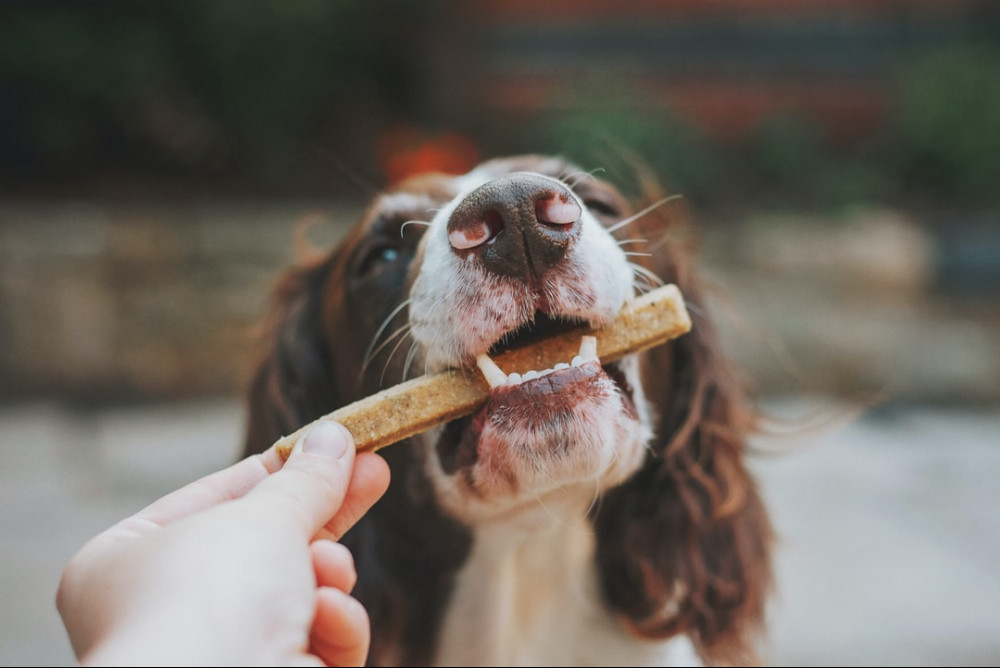Pet owners love to show affection for pets by giving food, treats and toys. Unfortunately, the wrong types can cause serious harm to your pet.
We have a problem.
Dogs chew. It is a natural part of canine behavior, particularly when a puppy. Chewing on appropriate toys can be used as a valuable component of training and well-being. However, hard dog toys and treats can cause serious harm. I see dogs with fractured and worn teeth from chewing on hard objects almost daily. Balls with fuzz on them, such as tennis balls, trap fine grit and dirt which acts as an abrasive and can seriously damage tooth enamel. Bones can cause intestinal blockage, perforation or inflammation. There are many other ways treats can harm dogs. For example, the FDA has ongoing warnings posted on their website about the risks of bones and jerky treats.
Cats are less prone to getting in trouble with treats and toys, but do have concerns which I review below.
Types of toys and treats to avoid:
- Bones of any sort, regardless of what sort and whether cooked or raw.
- Cow hooves.
- Deer antlers.
- Bully sticks.
- Nylabones or any type of hard plastic toy.
- Sticks or any sort of wood.
- Any material harder than rubber.
- Any ball or toy covered with fuzz (such as tennis balls) including fuzzy balls labeled as “safe” for dogs.
- Soft toys that can be shredded up and ingested (particularly those with a squeaker inside).
- Toys with fuzz, long threads, string or yarn.
So what is OK to chew?
The ideal type of toy for a dog is a durable yet soft rubber toy such as the classic Kong Brand toys. We want a toy that lasts, can’t be shredded up, but isn’t hard enough to break teeth. Chuckit! brand balls are excellent and can be a good source of exercise for dogs. Size of toy must be appropriate for the individual pet size.
Two brands of treats that are good for dogs’ and cats’ teeth deserve mention. Greenies and C.E.T. Brand chew treats are excellent for dogs. Cats tend to swallow the Greenies treats whole so they don’t appear to help as well for cats. The C.E.T. Brand dental treats for cats work very well. As of mid-2021 CET treats for cats are hard to find, but I do recommend keeping your eyes open for them.
One problem with treats though.
Treats can contain a surprisingly large number of calories, and may contribute to obesity. Give treats in moderation. However, dogs that are having problems with being overweight can have nearly unlimited raw green leafy vegetables as treats. Examples are carrots, baby carrots, celery, green beans or lettuce. Avoid starchy vegetables. Do not give cooked vegetables as treats when weight is a concern.
Another possible concern with treats.
I would still be wary of jerky treats, an ongoing issue. See here as well as below.
Additional thoughts on cats.
Cats tend not to spend a lot of time chewing on toys. However, many will show interest in catnip or toys with catnip in them, which is safe. The best type of edible treats for cats are essentially just cooked or dried meat. Laser pointers and toys such as a feather on a string are great at stimulating the natural predator instinct of cats. These sorts of toys should be used in a supervised manner only.
Cats are less motivated to eat foreign objects than dogs. However, cats do periodically eat things they shouldn’t, that then cause an intestinal obstruction (blockage). This can be life-threatening, and usually requires surgery. When cats eat objects they are usually what are called linear foreign bodies, such as thread, string and yarn. These sorts of items almost never pass through the intestines on their own.
You are what you eat?
You do need to be aware of where your treats come from. Many people are familiar with the epidemic of pets becoming ill associated with consumption of jerky treats. Most cases have involved products imported from China. The FDA is in fact still investigating well over 6000 cases, including more than 1000 dogs (even a small number of cats and people!) that have died from jerky treats.
It is important to realize that if a product is “Made in the USA”, for example, that does not mean that the ingredients must come from the USA. This applies to whatever country the product is listed as made in. The source of ingredients is not always available on the label. You may need to check directly with the manufacturer.
Do pets need treats and toys?
Remember that food and treats are not a substitute for interaction, affection and exercise, those last three things being by far the most important. Pets do not actually need treats. They simply need a high quality balanced diet, in an adequate amount to maintain ideal body condition. Appropriate toys can be a safe and beneficial addition to your pet’s life, both in terms of mental stimulation and exercise.

I saw a dog where the people were throwing rocks in the water for him to fetch. Hopefully it’s obvious now but this is a bad idea, both out of concern for damaging and breaking teeth, and also the possibility of swallowing a rock and having an obstruction.
Some dogs are so motivated to eat foreign material especially outside, that they need to wear a basket muzzle for protection.